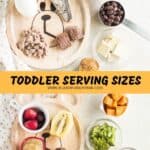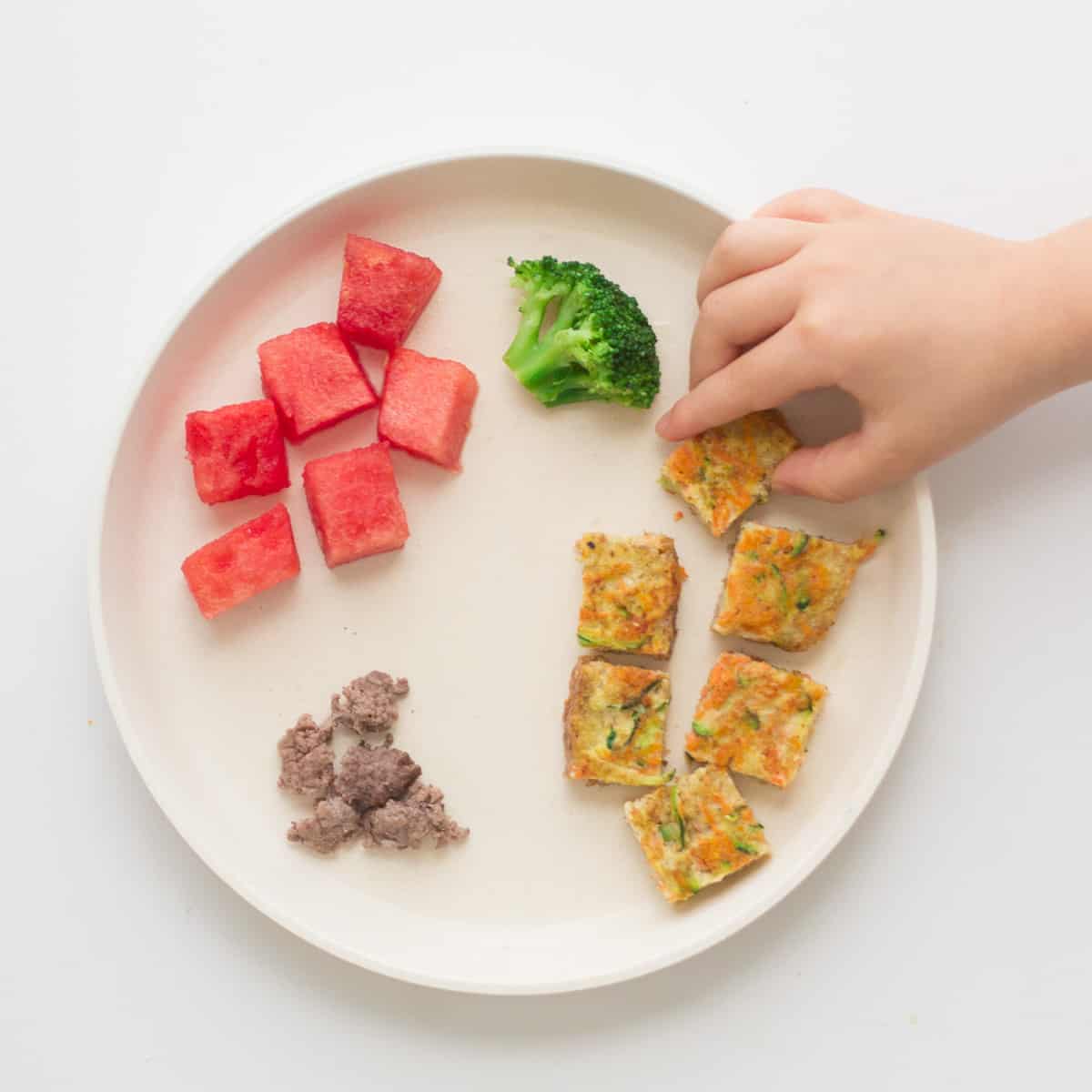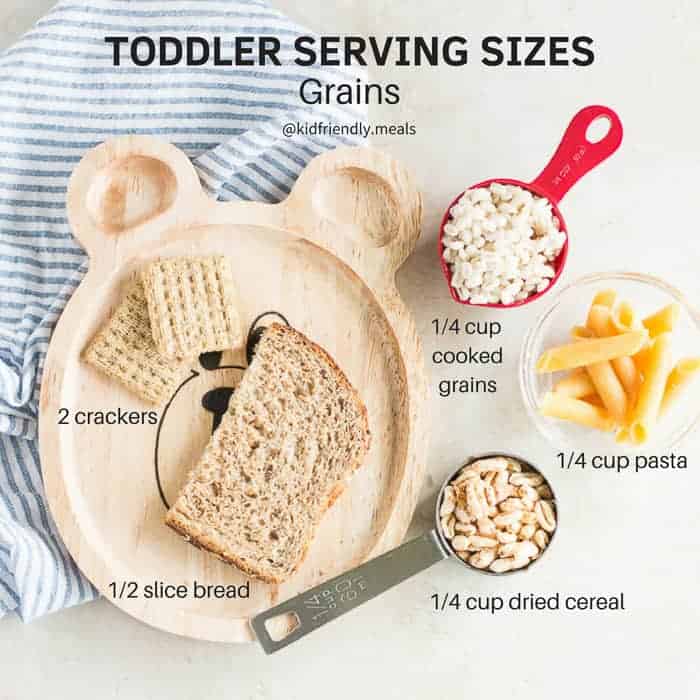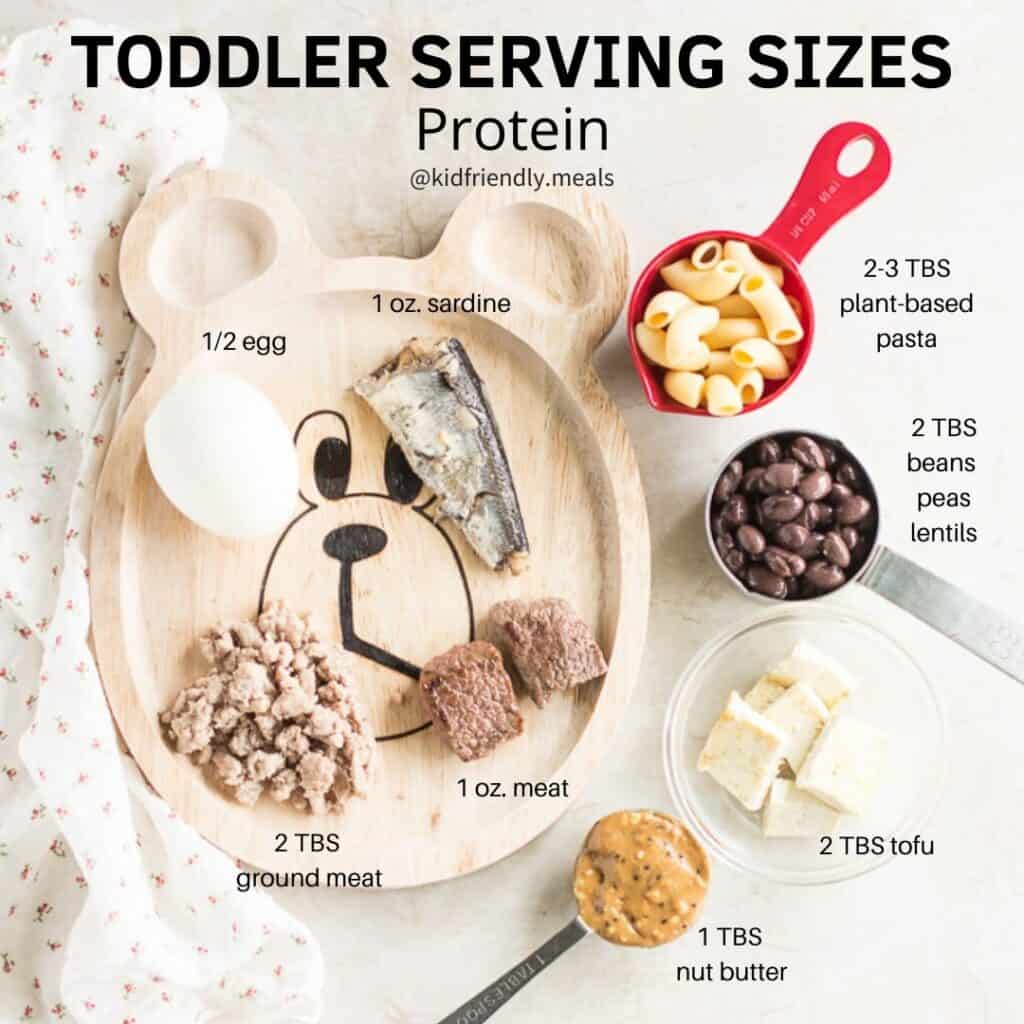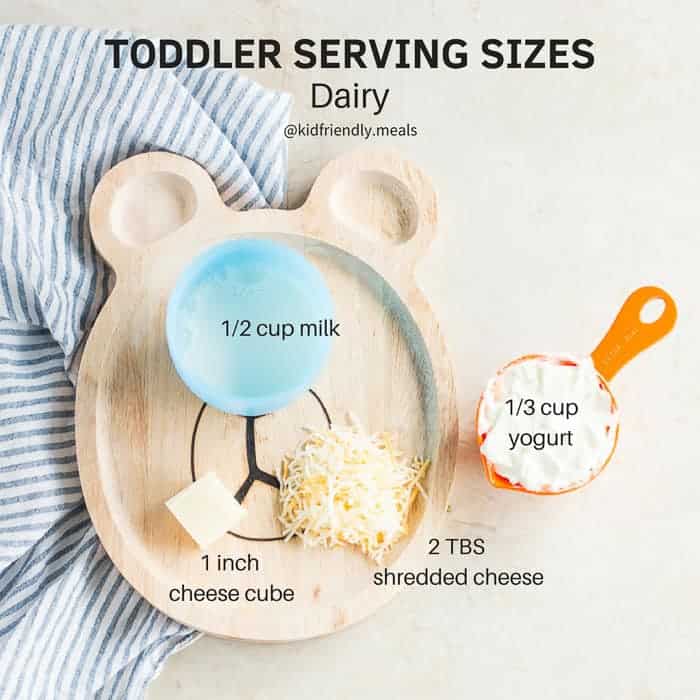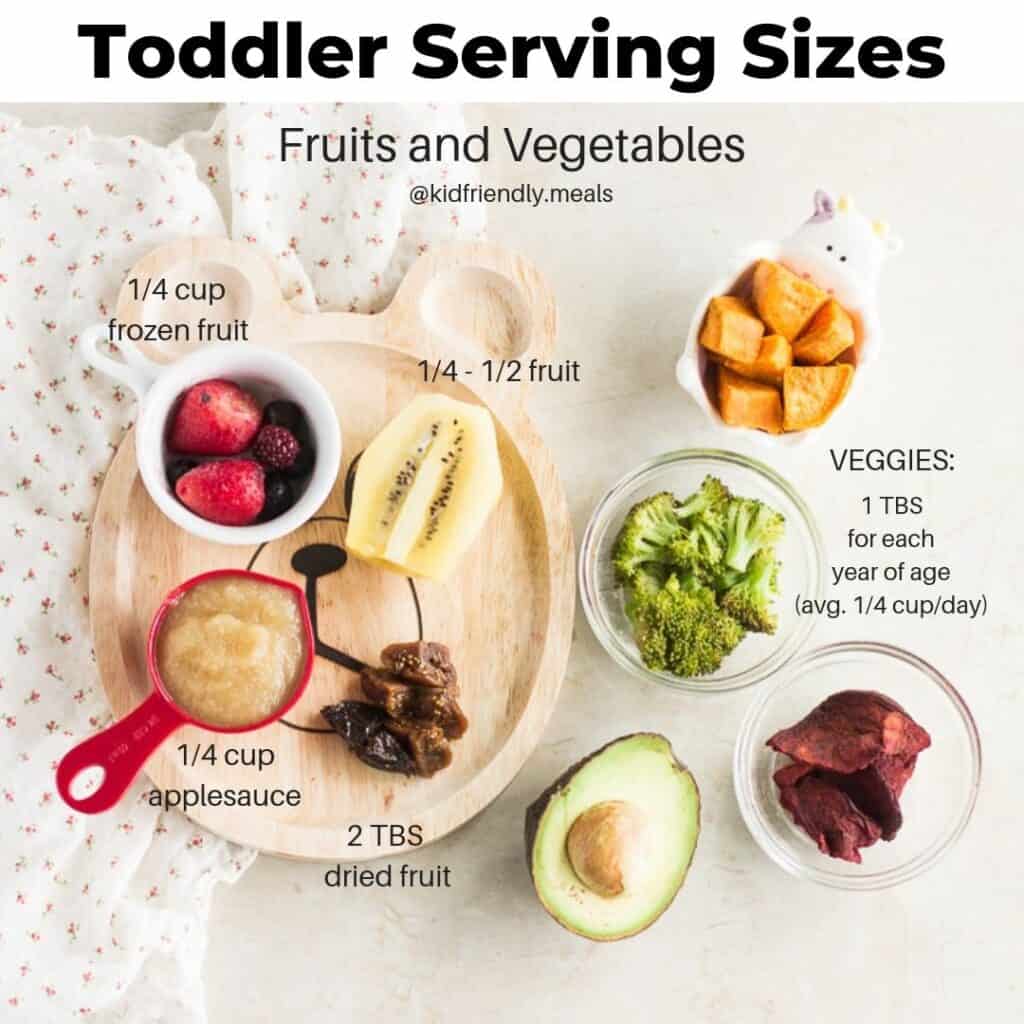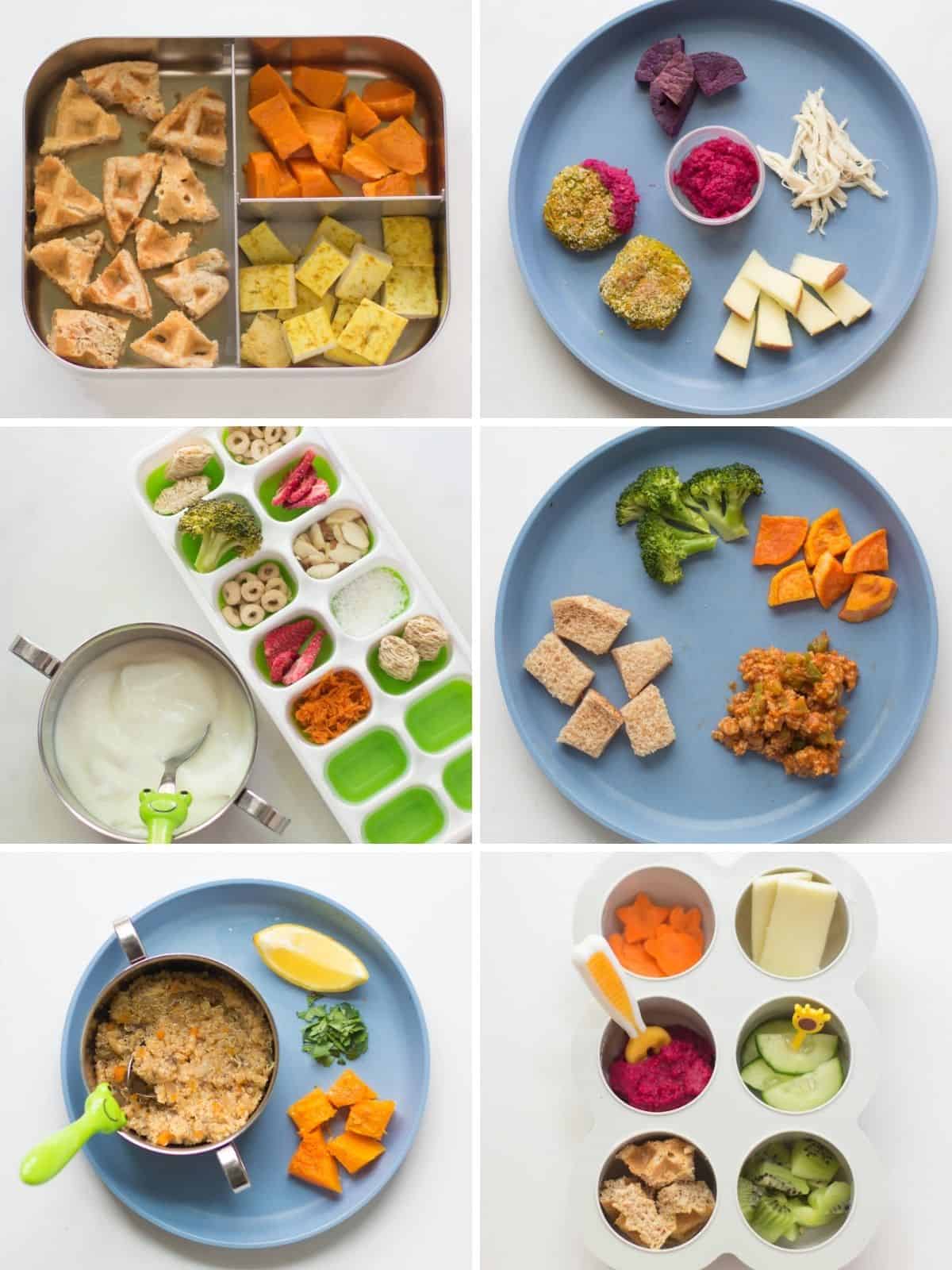You can very quickly spiral down the path of becoming obsessive and over-controlling. This is not an exact science. Rather, use them as starting points and a motivator to put together a well-balanced plate whenever possible as well as to try a new food. You can find examples of what I serve to my kids on Instagram @kidfriendly.meals
Portion Size vs. Serving Size
First, it’s important to address that while these two phrases are oftentimes used interchangeably, it’s important to note the difference! Portion size is the amount of food you CHOOSE to eat, which may be more or less than a serving. Serving size is a standardized, measured amount of food, which is what I’ve provided below. It may be used to quantify recommended amounts or represent quantities that people typically consume on a Nutrition Facts label. To put into perspective, 1/2 slice of bread is considered one serving BUT your child may eat a whole slice, which is the portion size.
How much food should a baby eat in a day?
There is no official recommended serving sizes for baby. And the appropriate portion size is however much your baby wants to eat. Practicing responsive feeding is so so important in setting a solid foundation of healthy, mindful eating. What we know for certain is that iron needs to be top priority! Here are some helpful resources:
Ultimate guide to baby led weaning Top foods for 8 month old Best baby finger foods
How much food should a toddler eat in a day?
Again, the appropriate portion size for toddlers depends on the child! My recommendation is to use the recommended serving sizes below as a starting point. BUT always always follow your child’s lead. Toddlers are really good at listening to their hunger and satiety cues! And as parents, as hard as it may be, we need to trust their cues rather than exerting our force. That can make mealtimes quite hairy for everyone and harm the parent child relationship. Related post: Help! My toddler won’t eat
Is my toddler eating too much or too little?
You might be saying “but my child doesn’t come close to eating this much food” or “my child eats way more than this.” I encourage you to think long-term and look at your child’s eating habits on a weekly and monthly basis rather than daily. I feel like as parents, we just love seeing our LOs eat and eat that we forget their appetites fluctuates just like ours.
For all of us tired parents and caregivers
Remember to give yourself grace if you aren’t able to put together a well-balanced meal day in and day out. My goal is to try to include 3 different groups at mealtimes and 2 at snack time. Does that always happen? Nope. But personally, goal-setting is one of the best motivators.
Toddler Serving Size – Grains
The recommendation, according to the American Academy of Pediatrics, is to aim for 6 servings per day. One serving equals:
1/2 slice bread 1/4-1/3 cup cooked pasta, rice, or other grains (millet, barley, kamut, farro, oats, etc.) 1/4 cup ready-to-eat cereal 2 small crackers 1/2 tortilla 1/4-1/2 bun, muffin, or bagel
“Help! My child only eats carbs!
I hear this ALL the time from parents so you’re not alone if hits home with you. Here are my top recommendations:
Don’t limit. As you can see, the recommended servings/day is pretty high. This is because carbs are essential for brain development and growth. They are so active at this age and they NEED the fuel Aim to offer a wide variety of grains, preferably whole grains at every meal and most snacks. If they only eat bread of pasta, instead of limiting, think about how you can boost the nutrition. For example, choosing products with more fiber, serving alongside dips like hummus, guacamole, nut butter. Even if they only eat the bread, they’re still getting that exposure to other foods, which is, again, HUGE! “But my toddler only wants to eat Goldfish, crackers, etc.”Again, you’re in charge of what to serve. Don’t give into their demands. But you also don’t want to overly restrict as that can fuel their obsession further. So have a structure in place just like you would with sweets – for example, serving Goldfish with lunch two times a week. Will things get hairy for a while? Probably. But they also thrive on predictability and structure.
Protein for Toddlers
The recommendation is to aim for 2 servings/day. One serving equals:
1 ounce of meat (two 1-inch cubes of solid meat or 2 tablespoons ground meat) 1 ounce fish or shellfish 1/2 egg 2 tablespoons cooked dry beans and peas, lentils 2 tablespoons tofu 1 ounce tempeh 2 tablespoons hummus 1 tablespoon nut butter
Serving Size for Toddlers – Dairy
The recommendation is to aim for 2-3 servings/day. One serving equals:
1/2 cup milk (here are the best milk choices for toddlers) 1/2 ounce (1 inch cube) cheese 2 tablespoons shredded cheese 1/3 cup yogurt or cottage cheese
Toddlers from 1-2 years of age can be breastfed or served WHOLE fat milk (if doing cow’s milk) The American Academy of Pediatrics recommends that fat not be restricted in children younger than 2 years. Deficiencies in essential fatty acids affect the maturation of the central nervous system, impede growth, and deprive them of nutrients such as fat-soluble vitamins (vitamins A,D,E,K).
Toddler Serving Size – Fruits and Vegetables
The recommendation is to aim for 2-3 servings/day each. One serving equals:
1 tablespoon vegetables for each year of age (an average of 1/4 cup per day) 1/4 cup chopped fresh, cooked, or frozen 1/4 – 1/2 small fruit/vegetable 1/4 cup (2 oz.) fruit juice. limit to no more than 4-6 ounces/day 2 tablespoons dried fruit
Personally, I like to group them together and aim for 5-6 servings of fruits and vegetables per day. Some days he eats more veggies, some more fruits, but it all evens out at the end. Or so I think, but hey! This is not exact science. A note about frozen fruits and veggies: My freezer is never without them. They are budget-friendly and convenient bc you don’t have to wash, peel, chop, etc., and won’t go bad before you can eat them. They are also flash-frozen within hours of being picked and thus can retain higher levels of some nutrients than fresh ones. Here’s a guide to cook frozen vegetables!
Best Tips for Offering the Right Portion Size for Toddlers
Less is more – oftentimes we overestimate how much food our child should eat. So many families come to me worried that their toddlers aren’t eating enough vegetables. Did you notice that the recommended serving size is 1 tablespoon per age? So start small! You can always offer more IF your toddler seems interested. Follow a feeding schedule. Their tummies are small and constant grazing and filling up on drinks can greatly impact mealtimes. Let them get hungry (not starving). They will be more willing to join you at the table. Don’t Pressure your toddler to eat more or clean their plate! It will only backfire. Instead make family mealtimes less about food and more about family. When we don’t make it a big deal and resist the urge to nag, force, bribe, that’s when magic happens.
For more guidance on how to make feeding your toddler less challenging and more enjoyable, be sure to sign up for my newsletter.
